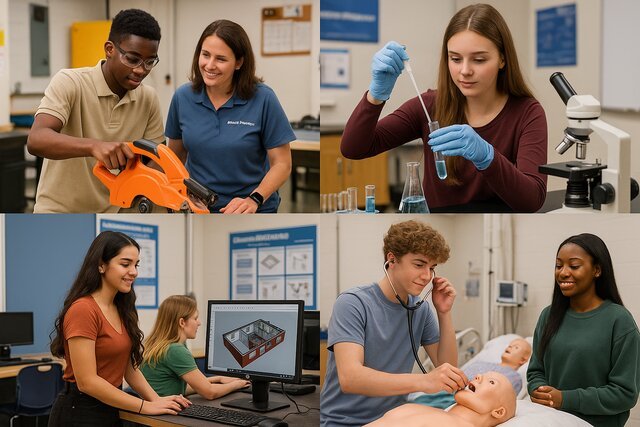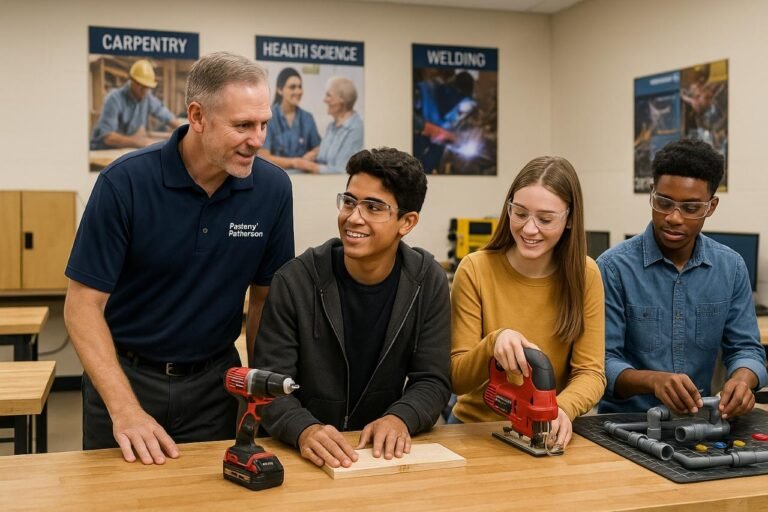Introduction
In today’s rapidly changing world, schools are under increasing pressure to prepare students not just for tests, but for real-world success. Employers demand practical skills, problem-solving ability, and adaptability, qualities that traditional classroom instruction alone cannot always deliver. This is where Paxton Patterson stands out as a leading innovator in Career and Technical Education (CTE).
For decades, Paxton Patterson has been a trusted name in hands-on learning systems, STEM education, and career readiness labs. Their comprehensive approach helps schools create immersive learning environments that spark curiosity, build confidence, and prepare students for future careers in science, engineering, healthcare, and the skilled trades.
This article provides an in-depth look at how schools can implement Paxton Patterson programs effectively, from choosing modules and installing labs to training teachers, tracking outcomes, and aligning with local industries.
Establish Partnerships and Define Program Scope

The first and most essential step when bringing Paxton Patterson into a school is to establish a partnership and define the program’s scope.
Paxton Patterson does not offer a one-size-fits-all system. Each partnership begins with a consultation process to identify a school’s goals, student demographics, available space, and budget. School leaders collaborate with Paxton Patterson education specialists to determine which career clusters best match their vision, whether it is STEM, Health Science, Architecture, Construction, or College and Career Readiness.
During this planning phase, administrators outline how many modules to include, which grade levels will participate, and what the schedule will look like. Some schools implement a full-time CTE elective, while others introduce Paxton Patterson labs as an enrichment or exploratory rotation.
Establishing clear objectives early ensures that the implementation aligns with student needs, local workforce demands, and district priorities. A well-defined scope also streamlines future steps such as budgeting, space allocation, and teacher assignment.
Select Career Clusters and Modules
Once the partnership framework is established, the next step is to select the career clusters and modules that will shape the student learning experience.
Paxton Patterson organizes its curriculum into multiple career clusters, each representing a real-world industry sector. Within each cluster are modules, or learning stations, that introduce students to specific professions, technologies, and skills. These modules are designed to be completed independently or in small teams, promoting autonomy and collaborative problem-solving.
Some of the most popular clusters include:
- STEM and College & Career Ready Labs – Students explore areas like digital manufacturing, robotics, alternative energy, aerospace, and computer-aided design. These modules inspire innovation and creativity, helping learners connect math and science concepts to tangible outcomes.
- Health Science Careers – This cluster immerses students in healthcare-related fields such as nursing, biomedical engineering, veterinary science, emergency medicine, and medical imaging. Students gain early exposure to anatomy, medical tools, and patient-care scenarios.
- Architecture and Construction – Focused on the skilled trades, these modules teach students how to read blueprints, frame walls, use hand and power tools safely, and understand construction materials. They bridge the gap between theoretical learning and craftsmanship.
- Family and Consumer Sciences – Students develop life and career skills through modules on personal finance, child development, and culinary arts. These labs strengthen practical competencies that support everyday independence.
By carefully selecting clusters and modules, schools can build a curriculum that reflects student interests, community workforce needs, and the school’s overall educational mission.
Install Labs and Equip Classrooms

After selecting the modules, schools must install the labs and equip classrooms to deliver an authentic, safe, and engaging experience.
Paxton Patterson is more than a curriculum provider; it is also a full-service equipment supplier. The company delivers all the necessary lab furniture, tools, and technology for each module. Each workstation comes with specialized tools, supplies, and instructional materials designed for hands-on projects.
For example, a woodworking module might include saws, clamps, and measuring devices; a health science module could feature stethoscopes, mannequins, and medical instruments; and a digital manufacturing module may include 3D printers and laser cutters.
Before installation, schools must assess available space and ensure compliance with safety standards. Proper ventilation, electrical access, and storage for materials are all critical factors. Once equipment is delivered, professional installers set up lab furniture, configure tools, and ensure each station is operational.
A well-organized and safe lab environment sets the tone for learning. It allows students to immerse themselves in hands-on activities without unnecessary downtime or hazards, maximizing engagement and productivity.
Train Educators and Launch Curriculum
A Paxton Patterson program succeeds only when teachers are fully prepared to guide students through the learning process.
Teacher training is a cornerstone of successful implementation. Instructors receive in-depth professional development covering module operation, classroom management, assessment techniques, and safety procedures. The training helps teachers transition from traditional lecturing to a facilitator role, where they support student inquiry rather than deliver constant instruction.
Paxton Patterson’s learning system is designed to promote autonomy. Students rotate through modules at their own pace, completing challenges and documenting findings. Teachers monitor progress through an integrated learning management system that tracks completion, assessments, and reflections.
When the curriculum launches, educators introduce students to each career cluster, explain safety protocols, and demonstrate how to navigate modules. Students then engage in real-world problem solving: designing prototypes, diagnosing medical cases, or analyzing construction plans. This dynamic learning environment fosters motivation, accountability, and curiosity.
Monitor Student Engagement and Outcomes
Once the labs are operational, schools must monitor student engagement and outcomes to ensure that the program achieves its educational goals.
The Paxton Patterson model emphasizes student ownership. Learners are encouraged to reflect on their work, identify personal strengths, and consider future career paths that align with their interests. Teachers can collect data on module completion rates, skill mastery, and attitude shifts toward STEM and technical fields.
Tracking engagement is more than just recording grades; it involves observing enthusiasm, teamwork, and creativity. Administrators should evaluate how well students transfer skills from the lab to core academic subjects, such as applying math in construction measurements or biology concepts in health modules.
Schools can also compare pre- and post-implementation data, including attendance rates, course enrollment trends, and standardized test scores. Many institutions report increased motivation and improved behavior among students involved in hands-on learning environments.
This continuous feedback loop allows educators to refine the program, adjust module offerings, and ensure that each lab remains relevant to current workforce trends.
Align with Industry and Post-Secondary Pathways
To maximize long-term impact, schools should align Paxton Patterson programs with industry certifications and post-secondary opportunities.
The career clusters mirror real sectors of the modern economy, allowing educators to connect classroom learning with community partnerships. Schools can collaborate with local businesses, trade organizations, and technical colleges to create mentorships, internships, or dual-credit opportunities.
For example, students who complete a biomedical engineering module might visit a local hospital or laboratory, while those in construction clusters could tour a building site or participate in an apprenticeship program. These connections make learning tangible and inspire students to pursue further education or training in their chosen fields.
Many districts also align Paxton Patterson modules with state CTE standards, ensuring that students earn recognized credits toward graduation or industry credentials. This alignment transforms curiosity into opportunity, positioning students for success in college, apprenticeships, or direct employment after high school.
Integrate Soft Skills and Career Readiness Competencies
While the technical skills taught in Paxton Patterson labs are essential, soft skills are equally important. The company’s “hands-on, minds-on” philosophy emphasizes teamwork, communication, time management, and critical thinking.
Each module requires students to collaborate, share responsibilities, and solve problems under real-world conditions. These experiences develop confidence and leadership qualities that traditional classroom settings often overlook.
In addition, reflection activities encourage students to connect their learning to broader life skills such as understanding deadlines, budgeting materials, documenting progress, and presenting results. These experiences nurture adaptability, resilience, and professionalism, which are vital in any career path.
By blending technical and interpersonal skill development, Paxton Patterson creates well-rounded learners who are ready for the workforce of tomorrow.
Evaluate Program Success and Continuous Improvement
No educational initiative is complete without continuous evaluation and improvement. Schools should regularly assess how well their Paxton Patterson programs are performing across several dimensions: student outcomes, teacher satisfaction, equipment utilization, and community impact.
Periodic surveys can help identify strengths and challenges. Are students more interested in STEM after completing modules? Are teachers finding the curriculum manageable and engaging? Are local employers noticing an improvement in students’ practical abilities?
Based on these findings, schools can refine their approach by adding new modules, updating equipment, or modifying schedules to enhance efficiency. Continuous improvement ensures that the program remains relevant, sustainable, and impactful over time.
Sample Module Overview
| Career Cluster | Sample Modules | Key Learning Outcomes |
| STEM / College & Career Ready | CAD & Design, Robotics, Alternative Energy, Drone Technology | Students apply engineering principles, experiment with automation, and understand renewable energy systems. |
| Health Science Careers | Nursing, Veterinary Medicine, Biomedical Engineering, Emergency Medicine | Learners gain exposure to healthcare tools, anatomy, and patient-care simulations. |
| Construction / Architecture | Blueprint Reading, Wall Framing, Carpentry Tools, Electrical Wiring | Students practice craftsmanship, structural design, and safety compliance. |
| Family and Consumer Sciences | Personal Finance, Culinary Arts, Child Development, Interior Design | Builds everyday skills such as budgeting, nutrition, and creative design thinking. |
Benefits of Implementing Paxton Patterson Programs

1. Real-World Learning Experiences
Students learn through doing. The hands-on format allows them to manipulate tools, analyze data, and produce tangible outcomes. This fosters engagement and retention far beyond textbook methods.
2. Early Career Exploration
Middle and high school students can explore multiple career paths before committing to a specialization. This helps them make informed choices about high school electives, college majors, or technical certifications.
3. Relevance to Local Workforce Needs
Because modules reflect real industry sectors, schools can tailor programs to match the employment landscape of their communities, preparing students for meaningful, in-demand careers.
4. Customization and Scalability
Schools can start small with a few modules or build a full CTE wing with multiple clusters. This flexibility allows districts of all sizes to implement the program within their financial and logistical constraints.
5. Comprehensive Teacher Support
Paxton Patterson provides professional development, technical assistance, and ongoing curriculum updates. Teachers have access to lesson plans, troubleshooting guides, and assessment tools that simplify management.
6. Student Empowerment and Confidence
Students take ownership of their learning journey. The independent, project-based approach helps them build confidence, initiative, and a sense of purpose, qualities essential for lifelong success.
Challenges and Considerations
While the benefits are significant, implementing Paxton Patterson programs requires thoughtful planning. Schools should anticipate and address challenges such as:
- Budget Constraints: Equipment and consumable materials involve initial and recurring costs. Strategic budgeting and potential grant funding can offset expenses.
- Space Requirements: Labs need sufficient room for safe equipment operation and student movement. Facility modifications may be necessary.
- Teacher Preparation: Instructors transitioning from traditional teaching may need additional support to adapt to a facilitation-based model.
- Maintenance and Upkeep: Tools, machines, and digital systems require periodic maintenance to remain effective and safe.
- Scheduling Logistics: Rotations between modules must fit within the school timetable without disrupting core academics.
By addressing these considerations early, schools can ensure a smooth, efficient, and sustainable implementation.
Conclusion
Paxton Patterson stands as a beacon of innovation in modern education, bridging the gap between classroom theory and workplace reality. Through structured career clusters, immersive labs, and data-driven outcomes, it redefines what it means to prepare students for life beyond school.
Implementing Paxton Patterson programs means more than introducing new tools; it means adopting a philosophy of learning that values curiosity, independence, and practical skill. When schools partner effectively, train teachers thoroughly, and connect programs with community industries, the results are transformative. Students graduate not only with knowledge but with the confidence and competence to shape their own futures.
Explore more insightful and valuable content on our blog VeoTag.com! Stay updated with helpful tips, expert advice, and in-depth articles that enhance your knowledge.
Read Also:
- Best Pumpkin Patch Near Me: Find the Perfect Fall Destination
- Kpop Demon Hunters Coloring Pages: Bring Your Favorite Heroes to Life
- GadgetFreeks.com: Your All-in-One Hub for Tech, Gaming & Streaming
- Purge costume: Ultimate Guide to Creating the Costume for Halloween
- Ex NBA Players Who Are Jehovah’s Witnesses: Careers and Life Beyond Basketball
FAQ’s
Paxton Patterson is recognized for developing hands-on, career-focused educational labs that integrate STEM, health science, and technical skills into K-12 curricula.
Each lab consists of multiple modules, self-contained learning stations where students complete projects related to specific careers or technologies.
Yes. The company offers modules suitable for grades 5 through 12, allowing younger students to begin exploring career interests early.
Teachers serve as facilitators, guiding students while the learning management system tracks progress, assessments, and reflections.
Absolutely. Every module mirrors an actual industry sector and is designed to introduce skills and knowledge relevant to current workforce needs.
Students gain hands-on experience, stronger problem-solving skills, and a clearer sense of direction for future education and careers. They become more motivated, self-reliant, and ready for real-world challenges.

